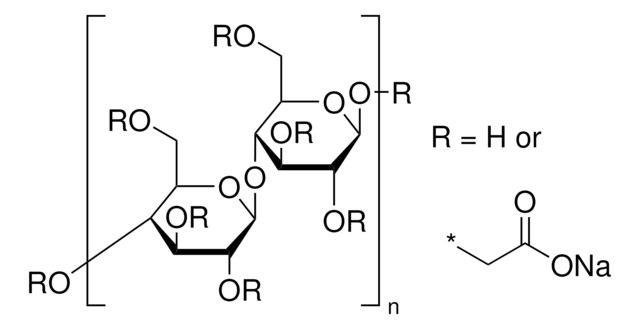C5678
Carboxymethylcellulose sodium salt
low viscosity
Sinonimo/i:
Sodium carboxymethylcellulose
About This Item
Prodotti consigliati
Origine biologica
synthetic (organic)
Livello qualitativo
Forma fisica
powder
Colore
light yellow
Intervallo di pH utile
(20 °C, 10 g/L, 68 °F neutral)
Viscosità
50-200 cP, 4 % in H2O(25 °C)
Punto di fusione
> 300.05 °C ((> 572.09 °F ))
Solubilità
water: soluble
Cationi in tracce
Na: 6.5-9.5%
Temperatura di conservazione
room temp
InChI
1S/C6H12O6.C2H4O2.Na/c7-1-3(9)5(11)6(12)4(10)2-8;1-2(3)4;/h1,3-6,8-12H,2H2;1H3,(H,3,4);
DPXJVFZANSGRMM-UHFFFAOYSA-N
Cerchi prodotti simili? Visita Guida al confronto tra prodotti
Descrizione generale
Applicazioni
Nota sulla preparazione
Under normal conditions, the effect of temperature on solutions of this product is reversible, so slight temperature variation has no permanent effect on viscosity. However, long periods of heating CMC solutions at high temperatures (autoclaving) will degrade the product and permanently reduce viscosity. CMC is therefore very difficult to sterilize. γ-Irradiation, like heating, will degrade CMC. High viscosity CMC is more adversely affected by autoclaving and irradiation than is low viscosity CMC. Filtering CMC solutions tends to leave a gel behind because the material is fibrous, so solutions cannot be sterile filtered.
Altre note
Codice della classe di stoccaggio
11 - Combustible Solids
Classe di pericolosità dell'acqua (WGK)
WGK 1
Punto d’infiammabilità (°F)
Not applicable
Punto d’infiammabilità (°C)
Not applicable
Dispositivi di protezione individuale
Eyeshields, Gloves, type N95 (US)
Certificati d'analisi (COA)
Cerca il Certificati d'analisi (COA) digitando il numero di lotto/batch corrispondente. I numeri di lotto o di batch sono stampati sull'etichetta dei prodotti dopo la parola ‘Lotto’ o ‘Batch’.
Possiedi già questo prodotto?
I documenti relativi ai prodotti acquistati recentemente sono disponibili nell’Archivio dei documenti.
I clienti hanno visto anche
Il team dei nostri ricercatori vanta grande esperienza in tutte le aree della ricerca quali Life Science, scienza dei materiali, sintesi chimica, cromatografia, discipline analitiche, ecc..
Contatta l'Assistenza Tecnica.

